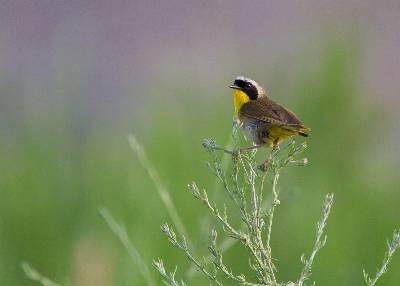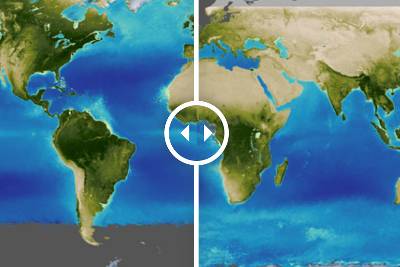For birds, earlier springtime means fewer young
Article Highlights
- A collaboration led by Michigan State University integrative biologist Casey Youngflesh has found that birds produce fewer young if they start breeding too early or late in the season.
- The mismatch between the start of spring and birds’ readiness to reproduce is likely to become worse as the world warms.
- Using climate models and projections, Youngflesh predicts that birds will produce significantly fewer young by the end of the century.
Rising global temperatures are making it harder for birds to know when it’s spring and time to breed according to a new study published in Proceedings of the National Academy of Sciences.

Casey Youngflesh, MSU postdoctoral fellow. Courtesy of Casey Youngflesh
A large collaboration led by Michigan State University integrative biologist Casey Youngflesh in partnership with researchers at the University of California, Los Angeles (UCLA), has found that birds produce fewer young if they start breeding too early or late in the season. With climate change resulting in earlier springlike weather, the researchers report, birds have been unable to keep pace.
The mismatch between the start of spring and birds’ readiness to reproduce is likely to become worse as the world warms, which could have large-scale consequences that would be catastrophic for many bird populations. Birds’ breeding seasons tend to begin when the first green plants and flowers appear (as these support insects that the birds feed on), which is happening earlier and earlier as the climate warms.
“By the end of the 21st century, spring is likely to arrive about 25 days earlier, with birds breeding only about 6.75 days earlier,” said Youngflesh, the study’s first author, who led the research as a postdoctoral researcher at UCLA and is now a postdoctoral fellow in the MSU Department of Integrative Biology in the College of Natural Science. “Our results suggest that breeding productivity may decrease about 12 percent for the average songbird species.”

In response to warming temperatures, spring is now arriving substantially earlier than it did several decades ago. Youngflesh et al. demonstrate that while North American songbirds, including the common yellowthroat (Geothlypis trichas), are shifting when they migrate and breed, they are failing to keep pace with the rate of climate change, resulting in fewer young being produced. Credit: Chris Sayers
This study is part of a larger collaboration researching the phenology—timing of natural phenomena—of plants, insects, and birds. After building the study’s analytical framework, Youngflesh worked with scientists from many other institutions as he tackled a longstanding question about birds—if timing is important for their breeding and why.
“For nearly 30 years, scientists have hypothesized that animals could become mismatched from plants as springs begin earlier,” said Morgan Tingley, a UCLA associate professor of ecology and evolutionary biology and the study’s senior author. “While there have been a few very good case studies of this phenomenon, it has remained a major mystery whether advancing springs will pose a general problem for the majority of species.”
Teaming up with The Institute of Bird Populations (IBP), Youngflesh and Tingley accessed the nonprofit’s long-term collaborative bird banding dataset known as the MAPS (the Monitoring Avian Productivity and Survivorship) project. Using additional data from satellite sensors, they determined springs’ arrival and compared it with IBP’s breeding data. The results showed a clear impact on how many young birds were produced.
“One of the novelties of this paper is the large scale, which wouldn’t have been possible without the decades of work from IBP,” said Youngflesh, who is also a member of the Ecology, Evolution, and Behavior Program at MSU. “Birds are a unique group to study because of this; data resources aren’t available on the same scale for other taxonomic groups.”

Over the past 50 years, satellites orbiting Earth have unveiled a remarkably dynamic planet. This image shows how plant growth on land fluctuates with the seasons (June and December). Credit: NASA Earth Observatory image Kevin Ward, using data provided by the Ocean Color Web and MODIS Land Science Team.
According to Youngflesh, birds are not keeping up with the pace of climate change. With each passing decade, spring’s arrival is several days earlier, and for every three or four days that it comes earlier, birds are breeding only one day earlier. Using climate models and projections, he predicts that birds will produce significantly fewer young by the end of the century. Given that North American birds have declined by about a third over the last 50 years, this is particularly concerning.
“Addressing phenological change is addressing climate change,” Youngflesh said. “If we know that some species are particularly susceptible to a warming world, or we know they are producing fewer young, we can focus on conservation in other areas, like protecting their habitat. We are seeing a cumulative effect; none of this happens in isolation.”
Funding for this study came from a National Science Foundation acrosystems grant and was supported by researchers at UCLA; the University of Florida; Pennsylvania State University; University of North Carolina, Chapel Hill; and The Institute for Bird Populations.Banner image: Over the past 50 years, satellites orbiting Earth have unveiled a remarkably dynamic planet. This image shows how plant growth on land fluctuates with the seasons (June and December). Credit: NASA Earth Observatory image Kevin Ward, using data provided by the Ocean Color Web and MODIS Land Science Team.